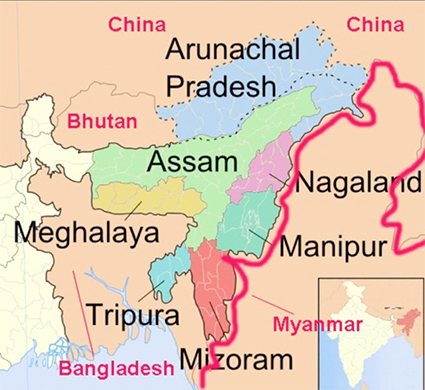Illegal Influx from Myanmar | 15 Mar 2021
Why in News
Recently, the Ministry of Home Affairs (MHA) has directed Nagaland, Manipur, Mizoram and Arunachal Pradesh to check illegal influx from Myanmar into India.
- The instructions have also been given to Border Guarding Force (BGF), i.e. Assam rifles.
- India already has a lot of Rohingya migrated from Myanmar.
- India, treats all refugees entering the country as illegal immigrants.
- In 2020, it was estimated that 40,000 Rohingya refugees lived in India, scattered across different states.
Key Points
- MHA’s Instructions:
- The State governments have no powers to grant “refugee status to any foreigner” and India is not a signatory to the United Nations Refugee Convention of 1951 and its 1967 Protocol.
- Similar Instructions were Issued in August 2017 and February 2018.
- The State governments have no powers to grant “refugee status to any foreigner” and India is not a signatory to the United Nations Refugee Convention of 1951 and its 1967 Protocol.
- Background:
- The directive comes weeks after the military coup and subsequent crackdown in Myanmar which led to several persons crossing over into India.
- The Tatmadaw, or Myanmar military, had taken over the country after a coup in February 2021.
- North Eastern States readily provide shelter to people from across the border as some of the states have cultural ties with some border areas of Myanmar and many people have family relations as well. This had resulted in some states taking a sympathetic view of those fleeing Myanmar and giving them shelter.
- Already there are clashes among the tribes (example Bru), more refugees will further aggravate the situation.
- Recent Influx:
- More than a dozen foreign nationals including policemen and women from Myanmar have fled to neighbouring Mizoram.
- India Myanmar Border:
- India and Myanmar share a 1,643 km border and people on either side have familial ties.
- Mizoram shares 510-km.
- Manipur shares 398-km.
- Arunachal Pradesh shares 520 kms.
- Nagaland shares 215 kms
- The border along the four states is unfenced and porous.
- India and Myanmar share a 1,643 km border and people on either side have familial ties.
- Free Movement Regime:
- A Free Movement Regime (FMR) exists between India and Myanmar.
- Under FMR every member of the hill tribes, who is either a citizen of India or a citizen of Myanmar and who is resident of any area within 16 km on either side of the Indo-Myanmar Border (IMB) can cross the border with a border pass (with one-year validity) issued by the competent authority and can stay up to two weeks per visit.
United Nations Refugee Convention 1951
- It is a United Nations multilateral treaty that defines who is a refugee, and sets out the rights of individuals who are granted asylum and the responsibilities of nations that grant asylum.
- It also set out which people do not qualify as refugees, such as war criminals.
- It grants certain rights to people fleeing persecution because of race, religion, nationality, affiliation to a particular social group, or political opinion.
- The Convention also provides for some visa-free travel for holders of travel documents issued under the convention.
- The Convention builds on Article 14 of the Universal Declaration of Human Rights 1948, which recognizes the right of persons to seek asylum from persecution in other countries.
- A refugee may enjoy rights and benefits in a state in addition to those provided for in the Convention
- The 1967 Protocol included refugees from all countries as opposed to the 1951 Convention that only included refugees from Europe.
- India is not a member of this convention.

